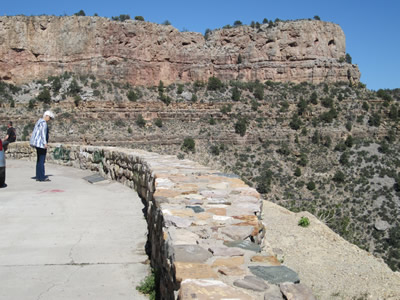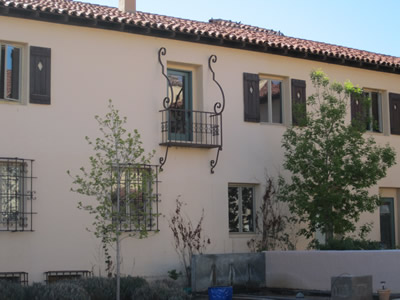
Red Rocks - Southwest trip, 2012
Biosphere, Arizona
Biosphere 2 (Biospere 1 is earth) was originally intended to demonstrate that life as lived on earth could possibly be emulated in a sealed environment and, eventually lead to colonies in space. The original experiment began in 1991 when plants, animals and 8 humans were hermetically sealed in the biosphere's glass dome. The original experiment had to be stopped due to insufficient caloric intake. The second phase with 7 people was stopped due to decreasing oxygen levels (it turned out that the still curing concrete was absorbing it). Eventually, the project was turned over to University of Arizona and is used for a variety of scientific multi-year research projects including research into the terrestrial water cycle and how it relates to ecology, atmospheric science, soil geochemistry, and climate change. Since biosphere 2 is no longer sealed it is also possible to visit the site. |
||||
 |
 |
 |
||
 |
Exterior and interior pictures of biosphere. In the interior different areas emulate various ecosystems, such as the savannah shown above. There are also a desert, rainforest and ocean environment. The picture on the right shows the Savannah. All of these areas continue to flourish today, only the animals were removed bevore Biosphere was opened to the public. However, birds and insects are still enjoying the various environments. On the right is the west "lung" of biosphere. Actually, it is a bladder but I guess someone felt that "lung" sounds better. Originally it and the companion east lung served to ensure pressure equilibrium in the closed biosphere system.. .Today it is a somewhat mysterious and slightly scary part of the tour - it is pitch dark and in the middle is an unsecured deep water pit. that is approached by visitors. Our group contained a little boy who immediately raised my "mom" instincts. He reminded me very much of Andrea when she was his age. Scary kid. But his mother was almost as quick as I in grabbing the little adventurer before things got dicey. Our visit to Biosphere 2 took longer than we had anticipated and as a result we abandonend our original plan to vist the Tonto National Monument on our drive to Winslow. Instead we opted for the more direct but wild and wooly route through the Fort Apache reservation of the Jicarillo Apaches. |
|||
| As the pictures below show, this route gave us a very nice and introduction to the type of scenery we would be enjoying for the next two weeks. The landscape is absolutely fantastic but you don't want to take your eyes of the road - so the passenger gets to tell the driver about the great view he is missing! As the pictures of the road indicated, we were starting to climb: from Tucson which with 2,400 feet is significantly higher than Camarillo (60 feet) we would be gaining altitude every day until we reached our high point - the devil's backbone in Utah with 9,300 feet. A lot of this gain in altitude occurs on roads with spectacular (and sometimes quite scary) views, as is indicated on the pictures below. | ||||
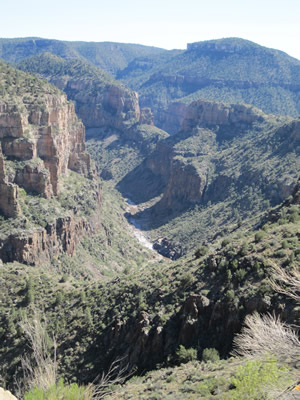 |
Jicarillo Apache Reservation
|
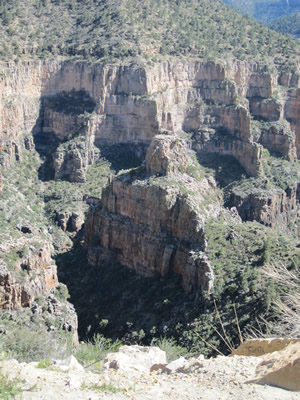 |
||
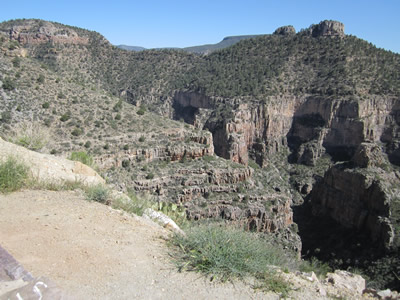 |
Our day ended at one of my favorite little hotels - La Posada in Winslow, Arizona. This was the last of the famous Harvey House Hotels, built in 1929. The harvey houses provided a welcome rest and/or meal stop for the travellers on the famous intercontinental trains of the early 20th century on their way from New York or Chicago to Los Angeles, Today the hotel is owned by an artist - Tina Mion and her husband. The artists influence is easily discerned in the indivualistic furnishings and decorations of the rooms and the grounds of the hotel. Additionally, the hotel has a very nice restaurant - the Turquois Room where my favorite foods are the Piki bread appetizer from Second Mesa and the Elk medallion with Huckleberry sauce. |
La Posada
Our room was the one with the balcony |
||
